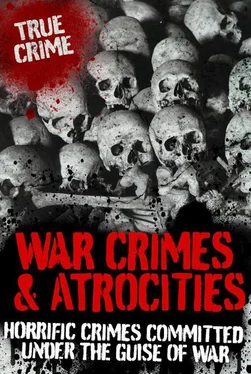On 22 March, Hamas leader Sheikh Ahmed Yassin, a 68-year-old paraplegic who was bound to a wheelchair, was assassinated by an Israeli airstrike as he left a mosque in Gaza City. Seven other Palestinians were killed in the attack and at least 17 more were injured. His successor, Abd al-Aziz al-Rantisi, was also assassinated on 17 April.
When Israelis opened fire on a nonviolent demonstration on 19 May, eight people were killed, including three schoolchildren, 10-year-old Walid Naji Abu Qamar, 11-year-old Mubarak Salim al-Hashash and 13-year-old Mahmoud Tariq Mansour. Many other unarmed demonstrators were wounded in the attack.
Palestinians have constantly been used as human shields during Israeli military operations, compelling them to risk their lives, despite the fact that this practice was banned by the Israeli High Court. In April 2005, Israeli soldiers forced 13-year-old Muhammed Badwan onto the bonnet of their jeep, tying him to the front windshield. They used him as a human shield to discourage Palestinian demonstrators from throwing stones at them during a demonstration in the West Bank village of Biddu.
In May 2005, the Israeli army destroyed approximately 300 homes and severely damged 270 other buildings in the Rafah refugee camp in the Gaza Strip. This left about 4,000 people without homes. When the IDF arrived with their bulldozers, many people were trapped inside their homes and they had to drill holes in the back walls in order to escape. Thousands of residents fled in fear, and UN schools were used as temporarily shelters to house the refugees. Israeli officials claimed the mass destruction was intended to further widen the ‘no-go’ area along the Egyptian border and to uncover illegal tunnels used to smuggle weapons into the Gaza Strip.
Following the death of two Israeli children in October 2005, the IDF launched a major attack on the Jabalya refugee camp in the northern Gaza Strip. This attack destroyed over 200 homes and buildings, and it also resulted in severely damaged roads and other vital infrastructures.
VIOLATIONS BY PALESTINIANS
Of course human rights violations are not just restricted to the Israeli army, Palestian armed groups have also killed 67 Israeli citizens, eight of which were children. The majority of these attacks were claimed by the al-Aqsa Martyrs Brigade, which is an offshoot of Fatah, and by the the armed wing of Hamas.
RESPECT FOR HUMAN RIGHTS
Until the Israelis and the Palestinians respect the law of human rights, there will be no peace or settlement in the area of the Occupied Territories. Even in the overwhelming majority of the thousands of cases of unlawful killings and other grave human rights violations, no thorough investigations have been carried out. As the growing tension between Israel and Palestine continues to mount, there is an ever-growing concern for the safety of the civilian population. Instead of improving, the situation looks as if it will deteriorate further in the light of the end of the fragile ceasefire, adding to the already deteriorating health and humanitarian conditions in Gaza and the West Bank.
Sabra And Shatila Massacres
1982

Sabra and Shatila were two refugee camps on the outskirts of Muslim Western Beirut. The camps were established when a large number of Palestinians sought refuge from Israel during the 1967 Six Day War against Egypt, Jordan and Syria. The issues leading up to the massacres, which the UN General Assembly condemned as an act of genocide, have been many years in the making and are extremely complex.
EVENTS LEADING TO THE MASSACRES
To put it as simply as possible, the Sabra and Shatila massacres were the outcome of an alliance between Israel and the Lebanese Phalangists. The Phalangists were a Christian political party and militia, who attracted Christian youths from the mountains north-east of Beirut as well as students from Beirut itself. At the start of the Lebanese Civil War, the Phalangists cooperated with Syria, but after 1982, Israel became their most important ally. In their long-standing war against Palestinian nationalism and the Palestine Liberation Organization (PLO), Israel were pleased to have the support of the Phalangists. Even though it was Israel who was responsible for the mass exodus of Palestinians, the hostility felt by the Israelis and the Phalangists against the Palestinians, led to them forming a secret alliance. Under the terms of this alliance, the Israelis supplied the Phalangists with money, arms and equipment to help them fight the PLO in Lebanon.
Although many have suggested that the massacres were a direct result of the murder of President Bachir Gemayel of the Lebanon and leader of the Phalangists, it was not a spontaneous act of vengeance, but a well planned operation. The Israelis were keen to motivate a mass exodus of Palestinians from Beirut and other parts of the Lebanon by means of mass terror. They had used this tactic before in a previous number of massacres, and it was a disturbing pattern of political struggle directed against innocent civilians – women, children and the aged population.
ISRAEL MOVE TO WEST BEIRUT
Initially, the Israeli government announced that its intention was to only penetrate as far as 40 km (25 miles) into the Lebanese territory. However, this was just a ruse, as Sharon had already planned a more ambitious project some months earlier. Having already committed a serious of violations against the civilian population in the south of the country, the Israelis proceeded to penetrate as far as Beirut. By 18 June, 1982, the Israelis had surrounded the PLO armed forces in the western part of the capital. The intensive shelling of Beirut resulted in the deaths of 18,000 people and a further 30,000 injuries, the majority of which were civilians.
The fighting went on for a period of two months, after which a ceasefire was negotiated via the US Envoy, Philip Habib. Under the terms of the ceasefire, the PLO was to evacuate Beirut under the watchful eye of a multinational force. The USA told the Palestinians that they would take control of the security of the civilians in the camps after the evacuation was completed on 1 September, 1982, but no such supervision was ever put into operation.
The decision to move to West Beirut was taken by the Israeli Prime Minister, Menachem Begin and Israeli Defence Minister, Ariel Sharon, even though it violated the ceasefire and broke Israel’s promise to US President Reagan, not to enter Beirut after the PLO’s evacuation. On 10 September, the multinational forces evacuated Beirut and the next day, Ariel Sharon announced that 2,000 ‘terrorists’ had stayed inside the refugee camps around Beirut.
PLANNING THE MASSACRE
On the evening of 14 September, Ariel Sharon and Israel’s Chief of Staff, Rafael Eitan, had a meeting in which plans were made to have the Phalange forces storm the two refugee camps. By dawn, on 15 September, Israel stormed West Beirut and cordoned off the Sabra and Shatila camps.
The following day a high-level meeting was held and the job of carrying out the operation was assigned to a major security official in the Lebanese forces, Eli Haqiba. Also present were the Supreme Commander of the Northern Forces, General Amir Dawri and Fadi Afram, Commander of the Lebanese forces.
The attack on the camps by the Phalangists militiamen started just before sunset on Thursday, 16 September, under the watchful eye of their Israeli allies. The Israeli army surrounded the camps, providing the Phalangists with the necessary support to carry out their heinous crime. They gave them bulldozers and a maps of the insides of the camps. Fired by the death of their Christian president, Bachir Gemayel, and the years of brutality they had suffered at the hands of the Palestinians during the PLO occupation of Lebanon, the Phalangists set about their three-day orgy of rape and slaughter. To give them more light, the Christian militia set off incandescent bombs into the air so that none of the Palestinians would be able to escape. Those who did try to escape the killing and rape – women, children and the elderly – were quickly brought back to the camps by the waiting Israeli soldiers. By Saturday morning, 18 September, the massacre had reached its peak and thousands of Sabra and Shatila camp refugees had been slaughtered.
Читать дальше













